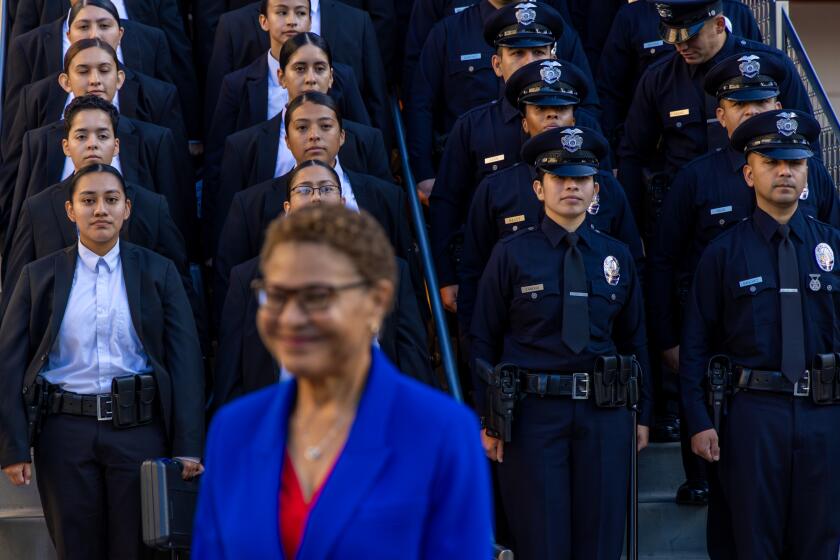Lack of Radio Cited in Summer Wildfire Deaths : Investigation: Report on Aug. 20 Glenallen blaze also says deviation from safety rules may have caused two men to be trapped by flames.
- Share via
An apparent communications breakdown and deviation from safety rules contributed to the deaths of two wild-land firefighters trapped by flames racing up a steep canyon during a late summer brush fire above Altadena, according to portions of an investigative report released by authorities Friday.
The Aug. 20 blaze marked the first time in 25 years that Los Angeles County wild-land firefighters--unsworn personnel trained specifically to fight brush fires--have been killed in the line of duty. Arthur Ruezga, 33, of Valinda and Christopher Drake Herman, 25, of Downey died and two others were severely burned in the blaze dubbed the Glenallen fire.
Since then, 12 investigators from the county Fire Department and the U.S. Forest Service have tried to figure out what went wrong along a steep canyon ridge where nine firefighters from Camp 2 in La Canada Flintridge were trapped.
The Times obtained a four-page overview of the report Friday. The complete, 100-page document will be released early next week, officials said.
The report does not blame anyone for the deaths and injuries, but serves as a comprehensive account of the Aug. 20 incident and what went wrong, said Terry Ellis, district ranger for the Arroyo Seco District of the Forest Service and a member of the investigative team. He said other fire departments will read the report and determine how they can avoid such incidents.
When the crew members were dropped off by a helicopter atop a ridge, the blaze was well below them and nearly contained to about 10 acres. The firefighters, who were using hand tools to cut a fire break along a ridge above a draw, did not see the flames that suddenly darted up to them until it was too late.
Four of the crew members--those who were killed or injured--did not have time to use their emergency fire shelters--aluminum coated, tent-like devices that can in most cases protect a firefighter from flames. The other five did, and walked away almost unscathed.
Several factors led to the crew’s entrapment, the report says. Principally, the firefighters did not have an adequate escape route from the steep hillside and they were not--as required by standard firefighting orders--in continuous radio contact with other crews on the ground that could see the main fire and advise them of any sudden shifts.
It is unclear whether crew members were simply not making an effort to communicate or tried but were unable to make contact because the radio frequencies were overloaded, Ellis said.
Radio logs show that two minutes before the tragedy someone from the crew made a very garbled radio call. The next call, however, was clearer: The flames were upon them and the crew needed help.
Ellis said the helicopter that had dropped off the crew and was providing water drops in the area could not lend help because it was picking up a load of water.
There were other problems.
The crew posted a lookout in case the blaze shot up the hillside. But for reasons that Ellis said are unclear, that lookout was not equipped with a radio. Apparently, it had been accidentally left back at the camp.
By the time the crew members realized the flames were racing up slope, Ellis said, they did not have enough time to escape because they had to run up a hill that was so steep and full of loose soil that it was difficult to stand on.
Reflecting on the fires that have ravaged tens of thousands of acres in the Southland over the last two weeks, Ellis said: “Knowing what firefighters do out there, I think we’re fortunate we haven’t had more of these incidents. We’re lucky that when we have, we’ve usually avoided fatalities.”
County Fire Chief P. Michael Freeman and other fire officials who have read the report could not be reached for comment Friday because they were directing mop-up operations at recent fires.
Camp 2 crew members--who include about 30 young men and one woman, are toiling along the fire lines somewhere in the Santa Monica Mountains.
In an interview during the Kinneloa Canyon fire above Pasadena on Oct. 27, Camp 2 crew foreman Gaylord Ward said that he had been briefed on the report by officials.
“There were some things that happened on the fire that were not observed by the crew or the foreman,” he said, declining to elaborate.
More to Read
Sign up for Essential California
The most important California stories and recommendations in your inbox every morning.
You may occasionally receive promotional content from the Los Angeles Times.










